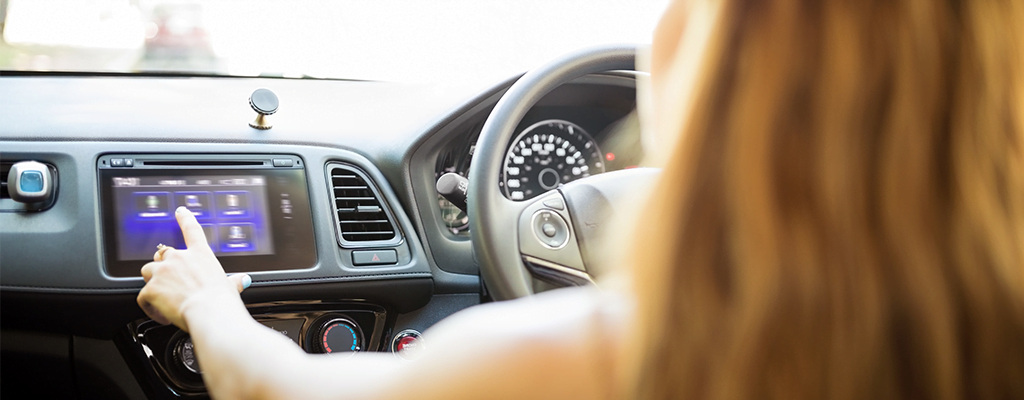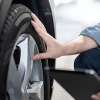
From Bluetooth to head-up displays, the amount of in-car technology continues to rise in both private and commercial vehicles. But with all of the systems and technology available to drivers, do the distractions they cause individually amount to a much larger issue? After all, when driving at a speed of 70mph, glancing away from the road for just two seconds mean a driver covers over 200ft without seeing any of the road ahead.
Below we take a look at what makes distracted driving so dangerous, what challenges businesses face, and offer some guidance for both fleet managers and drivers on the best ways to deal with them.
What makes distractions so dangerous?
- Mobile phone use increases reaction times.1 Research by Dr Graham Hole, author of The Psychology of Everything: Driving, has shown that using a mobile phone whilst driving both lengthens response times to unexpected hazards, and narrows a driver’s field of view to the point where they fail to notice emerging hazards in their peripheral vision.
- In-car infotainment systems can impair driving performance.2 Research commissioned by IAM RoadSmart found that infotainment systems increased average stopping distances to between four and five car lengths and that using touch control resulted in reaction times that were even worse than texting while driving. When performing navigation tasks, drivers deviated in their lane position by half a metre or more. Click here to learn more about our infotainment research.
“As a professional – I’m an LGV driver – I was pretty alarmed at how distracting it was. It certainly felt it was a few seconds at a time, but it was probably a lot longer.”
– Simulator test subject when asked “Did anything surprise you about using Android Auto?”
- Vigilance declines after about 20 minutes.1 Our ability to remain vigilant when focussing on a task such as driving can decline after around 20 minutes, making us more susceptible to distractions. This is particularly dangerous when driving a vehicle with many in-car distractions, as a driver may find it harder to remain focussed on the road and any hazards approaching when their vigilance naturally decreases.
- Semi-autonomous vehicles can cause complacency.1 Dr Graham Hole writes “with semi-autonomous [vehicles] you are reducing the driver to monitoring the system on the off-chance something goes wrong. Most of the time nothing goes wrong, leading the driver to have massive faith in the system in all conditions, which of course isn’t always the case.”
What challenges do fleets face?
- Tight deadlines. Whether it’s delivery routes or cross-country meetings, drivers may find themselves up against the clock when driving for work. While the destinations themselves are a necessity, it’s important for employers to manage these deadlines in a safe way that ensures any time constraints are not to the detriment of safe and controlled driving.
- Finding the time to take calls. For business drivers who are on the road most of the day, it can be a challenge when they need to contact others or be contacted themselves. However, it is now widely accepted that making a hands-free call is just as dangerous as hand-held due to the distraction of a phone call being the main risk to drivers, not the holding of the phone itself3. Therefore it’s worth requesting that your drivers avoid this altogether and pull over safely if they need to use their phone (with the engine off). Latest research from the RAC has shown no sign of phone-use trends slowing, with almost one-in-five (18%) of drivers aged 17-24 admitting to taking part in video calls while behind the wheel, and 29% of drivers of all ages in 2020 say they make and receive calls on handheld phones while driving.
- Reliance on technology. Some businesses may rely on in-car technology such as sat-nav for critical business operations such as route planning. While in these cases it’s never a viable solution to simply remove the technology from vehicles, correct training such as vehicle familiarisation can help to ensure that drivers are able to minimise the amount of focus they need to give the technologies to still use them safely. The training can also teach drivers the procedures to follow whenever they are required to drive an unfamiliar vehicle with new on-board features, meaning they can adapt to any future technology more easily .
Guidance for fleet managers
- Establish a safety culture. You may not always have the time to consider the culture of your business, or how it can influence driving behaviour, for better or for worse. However, promoting a culture of safety can bring many benefits such as reduced incident rates and a fleet that is more resilient to hazards on the roads. Click here for the best ways to get started, including how to get your driver training programme accredited by IAM RoadSmart.
- Update your fleet policy. A robust fleet policy can set out your expectations of drivers on a number of issues, including the use of distracting technology such as mobile phones. In a recent study, 67% of ‘gig economy’ drivers said their company gave no advice about using a mobile phone4. This clearly shows the need for more effective communication around an employer’s expectations on mobile phone use. For example, using a fleet policy document to clearly state that no driver will be expected to answer a hands-free call while on the move will eliminate pressure to take calls while driving for work.
- Discourage distractions. The recent conviction of a HGV driver showed a pattern of distracted driving in the leadup to a fatal crash5. Even if we know the difference between safe and unsafe driving, patterns of behaviours can form when a driver becomes complacent with distracted driving (such as on the phone or using their infotainment touchscreens). Discouraging the use of distracting technologies before they become routine can help to prevent serious incidents cause by a false sense of safety.
Guidance for drivers
- Most crashes happen close to home, so ensure that familiarity does not breed contempt by maintaining your focus when driving on frequently travelled routes. Glancing away from the road for a few seconds can make you miss that vital clue of a dangerous situation developing.
- Keeping your mobile out of sight and out of mind is the best way to avoid being distracted by it – we advise keeping it locked in a glovebox on silent mode.
- Get your sat-nav ready before you set off. This limits the chances of your needing to adjust it while on the move and takes away the likelihood of it causing unnecessary distraction.
- Distracted drivers swerve from lane to lane, drive too close to the car in front or react too slowly. As well as being a danger to other road users, this can bring you to the attention of the police who can issue a ticket at the roadside for careless driving.
- Eat and drink when parked. Not only does eating and drinking take your eyes off the road but dropped food and spilled drink don’t mix well with smooth and professional driving.
If you’d like to find out more about distracted driving, and its impact on the fleet sector, download our free whitepaper Driving While Distracted: Challenges and Solutions which takes an in-depth look at whether technology is helping or hindering drivers, and offers guidance on the best solutions for fleet managers looking to mitigate the risks associated with in-car technology.
Sources:
1: https://www.iamcommercial.co.uk/driving-while-distracted-challenges-and-solutions/
2: https://www.iamroadsmart.com/campaign-pages/end-customer-campaigns/infotainment
3: https://www.who.int/news-room/fact-sheets/detail/road-traffic-injuries
4: https://www.ucl.ac.uk/drupal/site_news/sites/news/files/a-survey-of-gig-economy-drivers-riders-and-their-managers_1.pdf
5: https://www.commercialfleet.org/news/latest-news/2020/08/10/hgv-driver-jailed-after-using-facebook-before-fatal-crash



